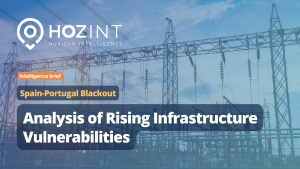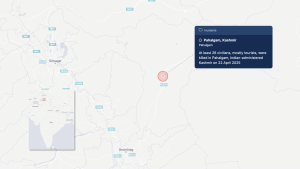Key Points
-
An unprecedented power outage affected large parts of Spain and Portugal on Monday, causing major disruptions in transportation, communication, and emergency services.
-
The outage resulted in a sudden loss of 15 gigawatts — around 60% of Spain’s national demand — within five seconds.
-
Authorities have ruled out a cyberattack so far but have not yet identified the cause, with sabotage concerns heightened amid regional geopolitical tensions.
-
Recovery efforts restored over 99% of power within 17 hours, with full recovery promised by the end of Tuesday.
-
The incident follows recent European infrastructure disruptions and ongoing fears of hybrid warfare tactics, including those potentially linked to Russia.
Event Description
What: A massive and unprecedented blackout hit Spain and Portugal, crippling transportation, communications, and public services across both countries.
When: The outage occurred at 12:33 p.m. (local time) on Monday. Partial power was restored by early Tuesday morning, with full restoration expected later that day.
Who: The governments of Spain and Portugal, the national grid operator Red Eléctrica, emergency services, and millions of civilians were directly affected.
Where: Mainland Spain and Portugal were heavily impacted. Notably, Spanish territories like the Canary Islands, Balearic Islands, and cities Ceuta and Melilla were unaffected.
Why: The cause remains under investigation. Spanish and Portuguese authorities have stated that there is no immediate evidence of a cyberattack but are exploring all possible causes.
How: The national grid experienced an abrupt loss of 15 gigawatts within five seconds, leading to a cascading failure across the Iberian Peninsula’s electricity system.
Operational Impact:
The power outage disrupted vital services:
-
Train services stranded about 35,000 people across over 100 trains.
-
Emergency services switched to backup generators.
-
Mobile communications, internet access, and banking (ATM) services were crippled.
-
Airports and metro systems faced shutdowns, causing chaotic travel disruptions.
- A state of emergency was declared by Spain’s Interior Ministry.
By 9 a.m. Tuesday, 99% of the network was recovered.
Analysis
The Iberian Peninsula blackout represents a critical event in Europe’s energy and security landscape. Spain’s Prime Minister Pedro Sánchez described it as the “first complete collapse of the system” in Spanish history.
Early reports suggest the outage may have been triggered by a rare atmospheric condition. According to Portugal’s electricity network operator REN, the incident may have stemmed from “induced atmospheric vibration” — a term loosely used to describe abnormal oscillations in high-voltage transmission lines caused by rapid shifts in atmospheric temperature and pressure. While not a standard term in meteorology or electrical engineering, this phenomenon appears consistent with known effects of gravity waves or thermal oscillations in the atmosphere.
These disturbances occur when warm air rapidly rises, for example, during a heatwave, creating a pressure imbalance with surrounding cooler air. The atmosphere compensates by forming wave-like patterns that propagate through air masses. If these pressure variations interact with long, suspended power lines, they can cause two types of damaging vibrations:
-
Conductor galloping – high-amplitude, low-frequency movement;
-
Aeolian vibrations – low-amplitude, high-frequency oscillations.
Both forms can severely stress structural components such as insulators, dampers, and support towers. Grid operators typically deploy stabilisation equipment like stock bridge dampers to mitigate these effects. However, such devices have performance limits and are designed for anticipated environmental norms — not the kind of sudden thermal shifts increasingly observed due to climate change.
While confirmation is pending, the hypothesis is consistent with broader climatological patterns and technical knowledge. In recent years, rising temperatures and rapid weather changes have introduced new variables into grid behaviour, particularly in southern Europe.
Nevertheless, the blackout across Spain and Portugal follows a concerning pattern of major infrastructure disruptions in Europe in recent years, highlighting the continent’s vulnerability to both accidental failures and potential hostile actions. On March 21, 2025, a major fire broke out in a substation that supplied Heathrow Airport — Europe’s busiest airport for international passengers. The power outage was caused by a fire at an electrical substation, temporarily suspending flights, stranding tens of thousands of travellers, and causing severe air traffic disruptions across Europe. While the UK authorities pointed to accidental causes (faulty equipment leading to the fire), security analysts noted that the event coincided with heightened concerns about Russian-backed hybrid campaigns against Western infrastructure. Even though no foul play was proven, the event triggered the British government to raise the national infrastructure alert level and led to calls for a broader European review of energy and transport network resilience.
The possibility of sabotage remains a latent concern. Although no direct cyberattack evidence has surfaced, the ongoing hybrid threat landscape in Europe, especially from Russian-linked operations targeting energy grids, transport, and telecommunications, cannot be ruled out.
Infrastructure Fragility: Centralisation Under Pressure
The blackout illustrates how modern energy infrastructure, though technologically advanced, remains structurally vulnerable. Europe’s energy networks are highly centralised, with interdependent transmission systems spanning countries. This design optimises efficiency but reduces tolerance to shock or malfunction. A single point of failure — such as a synchronisation error in a high-voltage node — can cascade rapidly across the grid.
Several structural stressors converge to intensify this vulnerability:
-
Renewable integration introduces intermittency and grid balancing challenges.
-
Electrification of transport and housing drives peak demand variability.
-
Cross-border transmission dependence increases complexity and reduces isolation capacity during regional failures.
While traditional failures, such as transformer malfunctions or line faults, are expected and manageable, large-scale disturbances driven by environmental variability are less predictable and harder to isolate.
The increasing interaction between physical weather systems and digital energy control infrastructure compounds this risk. Atmospheric conditions now directly affect not just generation, but the synchronisation and stability of transmission — a factor traditionally overlooked in resilience planning.
Critical Infrastructure Disruption and Cascading Effects
The immediate effects of the blackout extended far beyond energy availability. Emergency services operated on backup generators, though these are not designed for extended outages. Public transport systems, including subways and inter-city trains, were disabled. Airports experienced delays due to secondary system failures, while telecommunications networks lost signal in major cities.
Digital payment systems, including ATMs and point-of-sale terminals, went offline. Gas stations ceased functioning, affecting mobility and logistical continuity. Such cross-sector disruption illustrates the systemic nature of energy dependence in modern societies.
These failures also revealed shortcomings in public preparedness. In the absence of functioning communications, many civilians were left without reliable information. Public transport alternatives were overwhelmed, and improvised transport arrangements at major hubs like Madrid’s airport descended into confusion. In the absence of functioning networks, access to news, emergency alerts, and coordination systems was severely limited.
If power outages are prolonged and civil society is inadequately prepared, the resulting desperation and uncertainty could lead to mass unrest, including episodes of vandalism and looting. Therefore, equally important is civilian preparedness, including:
-
Public resilience campaigns outlining basic responses to major infrastructure failures.
-
Emergency kits, information dissemination via radio, and offline communication plans.
-
Simulated drills at municipal level for power, water, and telecommunications outages.
Forecast
Given the lack of clarity over the cause, two parallel developments are likely:
-
Short-Term (1-3 months):
-
Full forensic investigations into grid failure will be prioritised.
-
Enhanced cybersecurity and physical security measures across Europe’s critical infrastructures, especially energy grids.
-
Potential public outcry for government transparency regarding vulnerabilities.
-
-
Medium-Term (3-12 months):
-
Spain and Portugal are likely to overhaul contingency plans for national grid protection.
-
Heightened investment in energy resilience and backup systems will likely be seen across Europe.
-
Expect increased EU-wide coordination on infrastructure security frameworks.
-
If investigations find links to intentional sabotage, Europe’s already strained relations with hostile states (particularly Russia) could worsen, leading to new sanctions or cyber-defence escalations.




